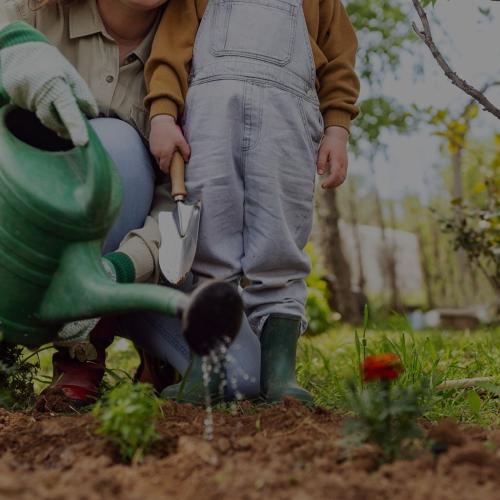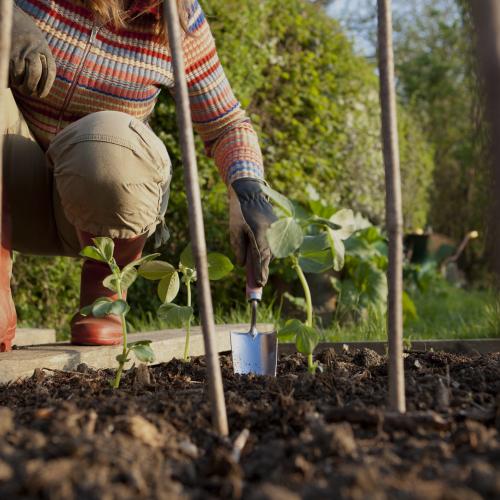April Hints & Tips
April is a marvellous month to be working in the garden, as the sun is beginning to warm up and the days are getting much longer. There is potentially so much to do in the garden now, but all the work you put in now will repay you magnificently later in the summer!
Discover our gardening hints and tips for this April:
Continue scrolling to read our monthly newsletter...
From the potting shed...
_1.1.jpg)
Blue Diamond's monthly gardening newsletter, written by our Great Amwell plant department colleague, Chris Milborne.
April 2025
April is definitely one of the most exciting months in the garden with longer days, warmer temperatures and increasing rays of sunshine. A week of glorious weather in early March brought the garden to life but it can still be chilly with rain and frosts. You will see more changes in the garden now than at any other time of the year.
Fresh, bright green or coloured leaf buds on branches of trees and woody shrubs are fattening and will unfurl by the end of the month leaving a wonderful canopy of leaves. Flower beds and borders that only a week or so ago, looked empty with just brown bare soil, will now be full of new growth with the promise of herbaceous perennials followed by the progression of flowering bulbs by the month’s end.
April in the garden is all about colour and new beginnings. There's plenty of flowers and blossom appearing on trees and shrubs and as the early daffodils, crocus and snowdrops fade, a fantastic array of tulips take over along with CAMMASSIAS and the colourful, sweetly scented wallflowers. The pale pink, scented flowers of CLEMATIS MONTANA will start to cover walls and trellis. This lovely climber has vigorous growth for any aspect and looks spectacular when grown through trees.
It is a very enjoyable time in the garden but very busy and it often feels like there are never enough hours in the day with all the sowing, pricking out, potting on, taking cuttings, planting out new trees and shrubs and planning for the year ahead.
Vegetables, fruit and herbs
Growing your favourite vegetables in April is so busy with none-stop sowing, propagation transplanting or potting on. There are so many benefits to growing your own fresh fruit, vegetables and herbs such as flavour, nutrition, how it saves money and its fun too! There is also a much wider choice of plants you can grow than what the supermarkets have to offer.
There are many colourful and different varieties of vegetable and fruit you can grow to make an attractive feature in the garden. If space allows, create a kitchen garden - a wonderful addition where you can plant colourful and decorative fruit and vegetables and add flowers for cutting and herbs too.
There are several ways this can be implemented, whether you’re growing neat rows of vegetables with traditional crop rotation that is easy to maintain when weeding, hoeing and harvesting, or try a potager style. This is an ornamental kitchen garden and the design dates back to the formal gardens of Renaissance, France using low growing hedging around the beds or using step-over fruit trees as a border. For the hedging use plants such as dwarf Lavenders, ILEX CRENATA or dwarf EUONYMUS. Fill the beds with colourful crops using contrasting colours such as green lettuce mixed with red leaved varieties. Create blocks of herbs, use BAY or ROSEMARY as a taller, central plant. Surround the area with beautiful trained fruit or patio fruit in large containers.
For a Cottage Garden style, mix flowers and vegetables together plus fruit and herbs. These planting styles date back to when gardens were a necessity for growing food crops, plants for homemade medicines, plants for cut flowers or for dyes.
Rustic wigwams made from tree pruning will add structure and height and can be used to support Runner and Climbing French beans or scented sweet peas. When planning and planting, mix together plants that contrast in colours. This also makes the plants less prone to pest problems and attracts more beneficial pollinating insects due to the wide range of flowers.
For small spaces and perhaps where crops are not needed in large quantities, raised beds are ideal, especially if the soil is not suitable. Raised beds also remove the need for digging, and make wedding and harvesting easier and look attractive and neat. For gardens that really lack space, use tubs and containers as most vegetable crops will produces a reasonable harvest providing, they are watered and have a weekly tomato feed.
For best results and for good water retention use a mix of John lnnes No 3 compost and 25% multipurpose compost. There is a wide range of pots to choose from in different styles, patterns and colours and made from different materials, to suit your garden schemes. Plant up a container of herbs such as Rosemary, Sage, Oregano, Parsley and Chives and place next to the barbeque for instant use.
Tips:
As a guide for fast growing crops like lettuce, rocket, spinach and radishes sow a small amount every 2 weeks for a succession of crops rather than a glut. Plant first earlies, second early and maincrop potatoes and add a good general fertilizer or line the trench with comfrey leaves or use grass clippings. Just make sure you haven’t used a weed killer. The decaying grass holds on to moisture and being slightly acidic helps prevent scab forming on potatoes.
Sow Broad beans, summer cabbage, early peas, beetroot, spring onions, lettuce, chard, spinach, rocket, parsnips and carrots outside. Once germinated and growing strongly, thin out and transplant seedlings and hoe as this prevents weed competition. Provide support for peas and broad beans sown previously.
Sow Courgettes, Marrows, Squashes, Pumpkins. French and Runner beans in a frost-free greenhouse, cold frame or polytunnel for planting out a May.
Strawberries are one of the easiest and most successful fruiting plants to grow. Plant 5 in a 15inch pot (33 cm) or use a hanging basket. Fill the container using John Innes No. 3 compost mixed with multi-purpose compost and after 5 to 6 weeks start feeding with a liquid Tomato feed and keep feeding every 2 weeks. Growing strawberries in a container or hanging basket makes it easier to protect ripening fruit from the birds and slugs.
Fruit trees on dwarfing rootstock remain compact and are good for growing in large containers or on a patio producing a reasonable crop. The best ones to try and that look good include Patio Peaches, Nectarines, Apricots, Apples and Cherries.
Remember if you don't fancy growing vegetables from seed or only require a few plants there is a large range of vegetable seedlings available to buy and grow on.
The changing season is all part of the excitement of gardening, always looking forward despite the changing weather conditions. April is a transitional period, where weather conditions slightly blur the seasons. As colourful spring plants, bulbs and blossom fade, now is a good time to plan for that gap before the displays of summer herbaceous plants burst into flower along with early flowering May to June annuals, biannuals, herbaceous and shrubs.
There are plenty of plant choices to provide continual colour through the season and to provide nectar for pollinating insects. Some of the most easy and reliable include HONESTY (LUNARIA ANNUA), Foxgloves - shades of pink, white, purple and apricot, Sweet Williams, Cornflowers, the yellows or oranges of Californian poppies, species of Hollyhock, VERBASCUMS, LUPINS, DORONICUM, BRUNNERA, PULMONARIA, EUPHORBIAS and Shrubs such as CYTISSUS, COTONEASTERS, CEANOTHUS, PYRACANTHAS and DEUTZIA. Also, bulbs like SNOWFLAKES, ALLIUMS, RANUNCULUS that comes in many colours and blue or white CAMASSIAS will all create that long lasting late spring/early Summer colourful display.
Sow half-hardy annuals for planting out in late May always good for any gaps in your flower borders. Good choices include Larkspur, Mallow, Cosmos Cornflowers, Tithonias, Zinnias and annual RUDBECKAS plus Dahlias single mix, like Bishop’s Children. This flowers in a range of colours such as reds and orange single flowers with dark foliage and is good for pollinators.
All these plants are available in a range of colours, some bright and hot and others have softer, more mellow tones.
A few top picks for April Spring colour are MAGNOLIA X SOULANGEANA with large pink shades, slightly waxy tulip-shaped flowers or for a smaller garden, MAGNOLIA STELLATA with white or pale pink star-shaped flowers. This is reliable and easy to grow in a sheltered spot in sun or light shade in free draining soil but with plenty of compost added.
Trees such as Apples, Peas, Plums and Cherries provide height and a focal point in the garden with their glorious spring blossom, fruit and then followed by colourful autumn foliage - plants for virtually all seasons.
CRAB APPLES have excellent blossom that is longer lasting than the ornamental cherry blossom and they are useful to pollinators and in the autumn, the colourful fruit is serves as an excellent feed for birds too.
Ornamental flowering Cherries have been grown in Japan for more than 1000 years, and are at their peak at this time of year. The flowers maybe single, semi-double or double and are available in a range of colours from bright pink to white or cream. Easy to grow in fertile, well-drained soil in a sunny sheltered spot so flowers last longer.
All gardens should have at least one or two early flowering shrubs. Many have attractive or fragment flowers such as SKIMMIAS or SARCOCOCCA CONFUSA or the or the VIBURNUM X CARLESSII AURORA. The highly scented flowers open on bare shoot tips and start off as balls of white or pink. VIBURNUM × BODNANTENSE DAWN is an easy to grow deciduous shrub that produces clusters of fragment pink flowers and as they age the flowers turn white.
BERBERIS is a range of deciduous or evergreen shrub and many varieties tend to have prickly leaves with clusters of orange, apricot or yellow flowers. LONICERA FRAGRANTISSIMA . bushy semi evergreen Honeysuckle, originating from China. The flowers are sweetly scented and are creamy white.
Other plants of interest CHOISYA AZTEC PEARL' an easy to grow evergreen shrub covered with white blossom in spring.
SPIRAEA ARGUTA is another easy to grow, reliable shrub which disappears under a covering of tiny white flowers at this time of year and is a plant that puts up with all weather conditions.
RIBES SANGUINEUM the ornamental flowering currant with its cascading clusters of reddish-pink flowers. The plant was used in medieval times to reputedly cure lung diseases. There is also a white flowering variety and all have blackcurrant scented foliage.
For sheltered areas, protected from hot summer sun or cold winter winds, grow Japanese ACERS. There are so many to choose from with their green, yellow, orange and reddish leaves unfurling at this time of the year. They have interesting bark and they make a good companion to spring flowering CAMELLIAS, RHODODENDRONS, AZALEAS and PIERIS. All enjoying the same growing conditions.
PIERIS ‘Flaming Silver’ with its young, bright red foliage develop variegated leaves as they age. The flowers are white or pink and are similar in shape to Lily of the Valley flowers.
To extend the interest throughout the summer months, grow HYDRANGEA ANNABELLE with large football sized flowers or other Hydrangea that enjoy the same ground conditions.
Other plants to consider include BRUNNERA an attractive herbaceous plant with big silvery-grey, patterned leaves and Forget Me Not-like flowers. Or try PULMONARIA, a ground covering plant with silvery white spotted foliage and clusters of pink, white or blue flowers. Tulips start to peak through this month – it’s a good idea to always grow a good mixture to extend the flowering period.
Now is also a great time to plant roses, many with fragrant flowers for summer displays transforming flower beds and borders. Climbing roses tend to be repeat flowering or rambling roses are good for covering bare walls, fencing and trellis or perhaps over pergolas and arches. The labels will indicate if they are scented or repeat flowering and as with most rambling and old species of roses, if they flower just once. Most of these produce wonderful coloured rose hips in the Autumn - just remember not to dead head these varieties.
Tips:
Put in plant supports round tall herbaceous plants at this time before they grow too large. These can be left in all year round as a reminder of what's been planted where, because when they die back in winter months it is easy to damage dormant roots and growth buds just below the surface when hoeing or forking over the soil.
As the soil is warming up and everything is starting to grow, spring is the time to feed trees, shrubs, climbers, evergreens and herbaceous perennials with fish, blood and bone or with a plant-specific food such as Rose Feed that is full of nutrients for strong growth. This is especially good for flowers on Rhododendron, Azaleas for ericaceous plats. Ericaceous feed is especially important for growth and flowers on Rhododendrons, Azaleas and other ericaceous plants. Once applied, lightly hoe or fork this in and then mulch with an layer of organic matter round the plants leaving a gap round the stems or trunks. This feeds the soil and helps maintain moisture in the soil over the forthcoming summer months and reduces weed growth.
Plant out summer flowering bulbs such as Lillies and Gladioli and plant dormant Dahlia tubers in rich fertile soil in a sunny spot for a wonderful display. In the summer, be careful when hoeing not to damage underlying new growth until the new shoots appear in May, watch out for slugs and snails.
If space is available in the greenhouse, I have found that starting Dahlia tubers off in pots establishes, good strong plants to develop before planting out in mid-May.
A few different bulbs to try are CANNAS, BLETILLA STRIATA, a hardy orchid and CRINUM POWELLI with trumpet-shaped blooms in shades of pink or white. Or BABIANA STRICTA with a mix of blue, magenta or mauve freesia-like blooms.
Prepare the lawn ready for lazy summer days. April is the time lush, new grass begins to grow. Much has been said about letting grass grow longer to create a wild flower lawn, but personally, in a smaller suburban garden, I prefer a neat, well-defined lawns (not necessarily with perfect stripes!) but this, to me, brings the garden together making the flower borders stand out for the insects and the garden looks tidy.
After the wet, winter weather followed by period of cold, lawns can look in a sorry state and are perfect for moss to establish. This can be tackled now by giving the lawn a good raking over and removing any thatch.
If the lawn is compacted this will result in bad drainage. Work over the lawn with a fork to a depth of 6ins (15cm) creating drainage holes. Redefine lawn edges will a half-moon, edging shears or a spad. This really makes a difference to the look of the garden.
Feed with an organic lawn feed high in nitrogen, this provides good strong growth and helps prevent competition from weeds.
To alleviate and remove bald patches in your lawn, mix a handful of lawn seed with multipurpose compost and sprinkle this mixture thinly over the bare patches that have been raked over. Add a layer of compost for good seed germination, lightly firm in and water and within a month this will provide a good, green covering. Mow, when the grass is approximately 1.5 ins (4cm ish).
Tie in long shoots of climbing and rambling roses and prune spring flowering plants like FORSYTHIA after the flowers have faded so that you don’t lose next year’s display if pruned later the year.
Plant up containers of Alpines together with conifers and heathers. With Alpines, select compact growing plants in a mixture of mound or rosette shapes with a few trailing types round the edges. Use a compost mixed with horticultural grit for drainage and top dress with gravel, small stones or slate chippings.
Houseplants
Increase watering and a regular feed as the weather warms. With any pot-bound specimens either repot into a larger container on top dress with some fresh compost.
Houseplants that caught my attention recently are ALOCASIA with its stunning architectural foliage and Alocasia Jacklyn with its prehistoric looking foliage that would create a wonderful display mixed with ferns and begonias with their interesting foliage. For example, Begonia cane ‘double dot' has polka dots on bright green foliage.
SARRACENIAS and Venus Fly Traps are fascinating carnivorous plants that are good for controlling insects such as gnats. Plant in a glass container surrounded by mini ferns, small foliage plants and pieces of bark.
Orchids are always a favourite too.
For many, Easter marks the start of the gardening year. Create an Easter inspired seasonal planted container using classic spring colours like powder blue, pastel yellows, potted late-flowering daffodils, yellow tulips, primroses, pansies, violas, hellebores, hyacinths and forget-me-nots.
The beauty of springtime in the garden or countryside just cannot be beaten so enjoy your garden.




